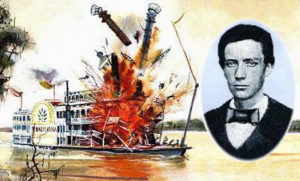
Everyone loves Mark Twain (nee Samuel Clemens). He was even one of the first popular American authors to be popular in Russia of all places. While he was in fact one of the first Americans to meet the Czar of Russia, he was also later popular with the Bolsheviks who prized his revolutionary stances. He remains a popular literary figure there to this day.
Of course, this is how I came to learn more about Mark Twain biographically, due to my interest in Russian subversion of America in media and my investigation of Orson Welles (he’s conservatively connected to at least 7 proven or strongly suspected Russian spies by the way as first degree network connections). Like Welles, Twain had odd connections to Russia for someone of his day — and while we might chalk this up to a financially irresponsible lifestyle and Twain’s constant desire to expand markets for his books — ultimately Twain was an innovator in painting a picture of an immoral America to the world (see Orson Welles as Harry Lime in The Third Man vs the controversy over release of Twain’s Huckleberry Finn in 1884). Not to get too Puritanical here, but there are also overlaps in themes of promotion of concepts like black magic and relative evil in the work of Twain and Welles as well (see Twain’s sympathetic portrayal of Satan / 44 / 404 in his final book ” The Mysterious Stranger”).
I won’t pull any punches here. I read Mark Twain as a school kid like many of you most likely did. I know it is sacrilege almost to disparage his memory. In any case, I think you might find what I have learned about him interesting. (Full disclosure I am putting together a draft which assesses Twain’s lifestyle against the Hare Psychopathy Checklist for a research paper which will be considered in a forensic psychology journal.)
The short story is that the young Samuel Clemens was a “cub” riverboat pilot who worked on the Steamboat Pennsylvania with pilot William Brown. In late 1857, the boat was involved in a collision with the steamer Vicksburg; leading to several months of repairs to the Pennsylvania. Following this crash, the relationship between the rigorous William Brown and Clemens never recovered. Later, Clemens (writing as Twain) confessed:
“I often wanted to kill Brown, but this would not answer. A cub had to take everything his boss gave, in the way of vigorous comment and criticism; and we all believed that there was a United States law making it a penitentiary offense to strike or threaten a pilot who was on duty. However, I could imagine myself killing Brown; there was no law against that; and that was the thing I used always to do the moment I was abed. Instead of going over my river in my mind, as was my duty, I threw business aside for pleasure, and killed Brown. I killed Brown every night for months; not in old, stale, commonplace ways, but in new and picturesque ones – ways that were sometimes surprising for freshness of design and ghastliness of situation and environment.” – Mark Twain in Life on the Mississippi
What this quote from Twain’s later life omits is the terrible tragedy which befell the Pennsylvania on June 13, 1858. It exploded on route killing approximately 250 of 450 passengers on board. All four boilers exploded. The explosion sent pilot William Brown flying into the water and to his death. It also killed Samuel Clemens’ brother, a promising young man by the name of Henry. Just prior to the explosion, the elder Clemens had arranged a place for him on the boat as the “mud clerk”. Fortunately for Samuel Clemens / Mark Twain, due to his conflicts with Brown, he had apparently been removed from his post some 8 days before and lingered somewhere down river on another boat and would follow up the Pennsylvania in short time.
It is easy to see Mark Twain’s conflict with Brown in its autobiographical context as described in “Life on the Mississippi”. However, according to a controversial 1912 biography by Albert Bigelow Paine, just before the disaster, and securing his brother a job — Twain apparently had a very prophetic dream that his brother would die. He made a point to demonstrate to their sister Pamela that he felt he had had some spiritual, or paranormal experience in this regard. (http://anomalyinfo.com/Stories/mark-twains-prophetic-dream) This detail is really impossible to corroborate, but significant in light of further data to follow which may make it a truly plausible claim of Twain’s.
Upon arriving at the scene of the exchange where a makeshift hospital had been set up to treat the victims of the Pennsylvania disaster, the young Henry Clemens was laying, dying on his deathbed. Samuel Clemens gave a tremendously dramatic performance which was noted by the crowds in attendance.
“We witnessed one of the most affecting scenes at the Exchange yesterday that has ever been seen. The brother of Mr. Henry Clemens, second clerk of the Pennsylvania, who now lies dangerously ill from the injuries received by the explosion of that boat, arrived in the city yesterday afternoon, on the steamer A. T. LACY. He hurried to the Exchange to see his brother, and on approaching the bedside of the wounded man, his feelings so much overcame him, at the scalded and emaciated form before him, that he sunk to the floor overpowered. There was scarcely a dry eye in the house; the poor sufferers shed tears at the sight. This brother had been pilot on the Pennsylvania, but fortunately for him, had remained in New Orleans when the boat started up.” – Memphis Eagle and Enquirer, 16 June 1858
In fact, some sources have examined this incident in Clemens’ life and and considered how his lifetime of confessed guilt and history of moral equivocations — including on the reputation of his brother may be evidence of murder. Specifically in the context that Henry Clemens did not die immediately – and may not have even succumbed to his wounds from the explosion – but instead may have died of an overdose of morphine which was administered by Samuel Clemens or at his behest.
Clemens was not an overly emotional fellow. His performance on the scene may not ring true in that sense. However, he did demonstrate many signs in life of being cunning and manipulative, one of the signs of psychopathy.
“It is easier to fool people than to convince people that they’ve been fooled”.
In general, he had alignment with psychopathic traits including living a grandiose financial lifestyle (for example going broke because he hired servants and bought a mansion when he could have lived well off of his writing income; not paying back debtors (until late in life when he may have had a moral reckoning); chasing the gold rush and coming up broke with dreams to be the best dressed man in San Francisco). He later institutionalized his epileptic daughter following the death of her mother on likely false charges she was dangerous even as he engaged in a potential romantic relationship with his young assistant. Later he would fire the assistant on similarly trumped up charges. As we see above, Twain/Clemens seems to have confessed to harboring murderous fantasies in some regard. The juvenile delinquent stories of Tom Sawyer and Huck Finn were drawn from his own mischievous youth. Of course, he has at one time dreamed of being a cocaine dealer which may signify his own need for stimulation. He surely confessed to being lazy and frequently bored. Controversially, he “collected” little girls, which his family also covered up and put an end to. His writings can easily be seen as glib and charming; yet belying the sometimes terrifying dual persona he projected to his own family and which they themselves continued to obscure in the years following his death. Many of these signs may be interpreted as hallmarks of psychopathy.
He did not (at least initially) write books for emotional satisfaction, or to make the world a better place for example — on the subject of authorship he said :
“But I’d made up my mind to one thing–I wasn’t going to touch a book unless there was money in it, and a good deal of it.”
Back to the Pennsylvania. Riverboat explosions were common in 19th century America. They were a dangerous mode of transportation. From the 1830 – 1870 period, there seem to have been about 2300 deaths on steamboats due to fires and explosions and dozens of accidents. This number is very loose, so I honestly expect it is higher. Normal casualties would be in the tens, not hundreds however. The most notable of these was the explosion of the ship Sultana in 1865 which was overloaded with Union Army prisoners of war who had been released from the notorious Andersonville prison. Up to 1800 people died in that tragic explosion of the approximately 2100 who had been overloaded on the boat. Subtracting this number from the total riverboat deaths of the 1830-1870 time frame, we’re left with about 500. Subtracting the 250 who died as a result of the four boiler explosion of the Pennsylvania in 1858, we can see that these two disasters make up a disproportionate share of the deaths even if the figures aren’t exactly correct.
What is notable beyond the outlier nature of the casualty data in the case of the Sultana and Pennsylvania, is that both have potential motives behind them and that Mark Twain is the common link between the disasters.
Twain was a confederate soldier for a short time. In The Private History of a Campaign that Failed, Twain talked about his meeting with Ab. (Absalom?) C. Grimes during an early part of the civil war in a somewhat hagiographic manner. In fact, they served in the same company and Twain enlisted on the same day Grimes had been accepted, according to Grimes’ obituary. Grimes later went on to become a notable confederate spy by Twain’s own account. Grimes and Twain might have gotten along well at their initial meeting, beyond being comrades in arms, as Grimes was a riverboat pilot too.
Later, Grimes would serve under Thomas Courtenay, a Missourian confederate spy chief who was the inventor of the “Coal Torpedo” — a 19th century IED device which was a lump of iron molded to resemble a piece of coal, fitted with a large shell, rolled in beeswax, dipped in coal dust and slipped into the coal of Union riverboats. The coal torpedo was used to sabotage and blow up enemy boats in a form of 19th century civil war guerrilla tactics. Grimes’ close associate, Robert Louden had supposedly confessed on his deathbed to the sabotage of the Sultana with a coal torpedo. Grimes did not corroborate this, but did say, “let sleeping dogs lie” when pressed on the matter. This deathbed confession was investigated in the interesting “History Detectives” episode here : http://www.pbs.org/opb/historydetectives/investigation/civil-war-sabotage/ .
Nobody can truly say whether either disaster was an accident or not. But both of these events were extreme outliers; with very plausible motives and if all of the evidence is to be believed — very compelling suspects. In any case, I think with the information and tools we have today, both of these events would get a lot closer look from investigators with an eye on the possible motivations. I wonder what Grimes and Samuel Clemens talked about when they met.
Thought some of you might find this interesting.
